Three Quarters of Amazon Sellers Are Profitable, and 95% Plan to Expand: Report
A new report claims that 76% of Amazon sellers are profitable in 2022, and 95% of them plan to expand their businesses this year.
The report, "The State of the Amazon Seller," was released by Amazon seller platform JungleScout and is based on data from 3,500 Amazon sellers.
The report found that while 90% of sellers experienced a negative impact from supply chain issues, that largely hasn't hurt their ability to turn a profit.
Nearly half of sellers -- 45% -- reported an increase in profits between from 2020 to 2021. Meanwhile, about a quarter of new sellers plan to sell their business to an aggregator.
Amazon sellers don't want to have all of their eggs in the Amazon basket. More than half are selling on Walmart and Shopify, which are two competitors Amazon has targeted in recent months in an attempt to get more market share. Also, nearly one in three sellers are exploring selling on platforms like eBay, Facebook, and Etsy.
Although things are going relatively well for sellers, they have some concerns. About two-thirds of all sellers are concerned that Amazon will start favoring paid results over organic results. And nearly two-thirds of sellers listed their top concern as increasing shipping costs.
"Continued supply chain woes will make inventory re-stocks and new product launches challenging," said one seller in the report.
Added another seller: "It’s going to be more competitive, new developments in areas like metaverse, virtual shops, crypto." (See The Metaverse: What Amazon Vendors and Sellers need to know)
“It’s striking that a quarter of sellers are already planning a sale to an aggregator,” said Reason CEO Andrew Hamada. “Five years ago aggregators were unheard of and now sellers are earning 8-10x revenue multiples every week. For anyone with Amazon or ecommerce expertise, it’s a great time to convert that expertise into capital.”


